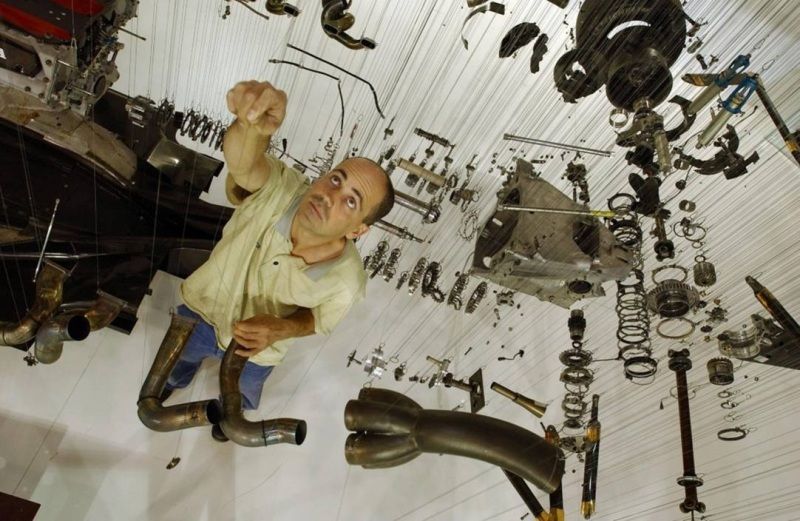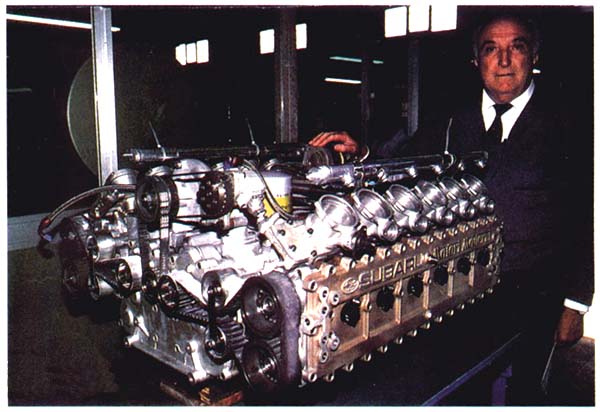Page 1 of 1
Formula 1 cars are made up of 80,000 components...
Posted: Wed Nov 04, 2009 2:44 pm
by kimokalihi

Gallery here
http://mrtperformance.com.au/content/view/745/238/
An F1 car is made up of 80,000 components, if it were assembled 99.9% correctly, it would still start the race with 80 things wrong.
When a F1 driver hits the brakes on his car he experiences retardation or deceleration comparable to a regular car driving through a BRICK wall at 300kmph!!!
A F1 car can go from 0 to 160 kph AND back to 0 in FOUR seconds!
F1 car engines last only for about 2 hours of racing mostly before blowing up on the other hand we expect our engines to last us for a decent 20yrs on an average and they quite faithfully DO....that's the extent to which the engines are pushed to perform..
An average F1 driver loses about 4kgs of weight after just one race due to the prolonged exposure to high G forces and temperatures for little over an hour (Yeah that's right!!!)
At 550kg a F1 car is less than half the weight of a Mini.
To give you an idea of just how important aerodynamic design and added down force can be, small planes can take off at slower speeds than F1 cars travel on the track.
Without aerodynamic down force, high-performance racing cars have sufficient power to produce wheel spin and loss of control at 160 kph. They usually race at over 300 kph.
In a street course race like the Monaco grand prix, the down force provides enough suction to lift manhole covers. Before the race all of the manhole covers on the streets have to be welded down to prevent this from happening! The refuelers used in F1 can supply 12 liters of fuel per second. This means it would take just 4 seconds to fill the tank of an average 50 liter family car. They use the same refueling rigs used on US military helicopters today.
Top F1 pit crews can refuel and change tyres in around 3 seconds. It took me 8 sec to read above point During the race the tyres lose weight! Each tyre loses about 0.5 kg in weight due to wear.Normal tyres last 60 000 - 100 000 km. Racing tyres are designed to last 90 - 120 km.
A dry-weather F1 tyre reaches peak operating performance (best grip) when tread temperature is between 900C and 1200C.(Water boils at 100C remember). At top speed, F1 tyres rotate 50 times a second.
Posted: Wed Nov 04, 2009 3:36 pm
by evolutionmovement
Engines are designed to last at least 2 3-hour races. If they don't, the driver is demoted 10 places at the next race from wherever he qualifies. Could be an outdated reference. Some small planes take off at speeds slower than I travel on the highway, so that's not a big deal. And the brick wall reference can't be right—that would have to be far more g's than a human could survive. I believe Dale Earnhardt hit the wall at about 180 mph (300kph), but was also moving sideways, which would've mitigated the g's experienced. Nevertheless, it was enough to kill him. It's a little different situation in that the road car would have airbags and moving belt to reduce g load as well as the brick wall theoretically giving way, but I still don't believe it. I think the deceleration is generally on the order of -4g, which is still damn plenty!
Posted: Wed Nov 04, 2009 3:41 pm
by kimokalihi
Yeah, I have no idea. Just thought it was cool, especially that suspended parts mockup. I couldn't imagine the frustration that would take part in that kind of project.
It was sent to me as part of the MRT newsletter I get somehow.
Posted: Wed Nov 04, 2009 4:27 pm
by gijonas
Tread temp of 1200C?!?!? or 2200 degrees?!?
Posted: Wed Nov 04, 2009 4:43 pm
by kimokalihi
Yeah I found that part pretty hard to believe too.
Posted: Wed Nov 04, 2009 4:59 pm
by PhyrraM
To add to the amazement:
The clearances on an F1 motor of a few years ago, and likely today still, are so tight that if the motor is cold it is essentially locked up. The teams run hot coolant and oil through them to bring them close to operating temperature before even turning them over.
And something that many folks don't realize:
They cannot be driven softly, say 8/10ths. Things cool off and no longer work properly. Brakes and tires are effectively non-exsistent until up to temperature (and kept at operating temp). There is simply not enough downforce to keep the tires warm or grippy unless your going 100%.
Arguably the fastest and most demanding cars to drive in the world HAVE to be driven at thier limit just to be safe.

How's that for a cheek clencher. Says something about the drivers too. (Even though, IMO, WRC drivers are better overall drivers)
Posted: Wed Nov 04, 2009 5:18 pm
by evolutionmovement
F1 vs. WRC drivers is tough. Who's won more Race of Champions? WRC is less abusive in that the g force involved is far, far less, though the races are longer. I don't think they're exactly comparable, but the WRC skills are more relevant to the real world.
One reason I have no interest in supercars anymore is that they aren't fun to drive at slow speeds due to the compromises needed to make the car capable of irrelevant 200 mph+ speeds. At least electronic controls have made the engines tractable, whereas the supercars of old were decidedly not. The performance in F1 is so high that those compromises are far greater.
Posted: Wed Nov 04, 2009 5:26 pm
by n2x4
Interesting stuff! Reminds me of the Topgear where hammond drives an F1 car.
Posted: Thu Nov 05, 2009 12:46 am
by jamal
tread temp isn't right. It is very high though - around 300C. The brakes probably hit 1200.
The reference doesn't mean hitting a brick wall and stopping, it means breaking through it.
Posted: Thu Nov 05, 2009 1:37 am
by PhyrraM
evolutionmovement wrote:One reason I have no interest in supercars anymore is that they aren't fun to drive at slow speeds due to the compromises needed to make the car capable of irrelevant 200 mph+ speeds.
I believe that is what makes the Buggatti a relative success. Other than the 1000HP figure and the "top speed" claim they seem to have disregarded most of what used to define a supercar. In super car terms, it doesn't handle or brake particularly well. It's kinda ugly. It's very heavy. It supposedly doesn't have that supercar "edgy" feel. But, supposedly, it handles the everyday grind acceptably well.
Is it fun below 150? I have no idea. I'll take an Elise if I ever find myself "in the market".

Once the built motor is in the white Legacy, I'm seroiusly considering building a mid-engined, tube framed car around a FWD trans and an SVX motor.
Posted: Thu Nov 05, 2009 2:24 am
by evolutionmovement
That would be an awesome project. The SVX engine is underappreciated. Stock power is good and turbocharged they can be ridiculous. The OSCA revival car was supposed to be a mid engine lightweight with Subaru power and that would've been a great car.
I think the Elise is one of the handful of actually intelligent cars being made today. If I weren't building my own prototype, I'd maybe get a used one. I want something that's fun in the real world of shitty roads, traffic, varying weather, rocks kicked up from cars ahead, shit falling off trucks, inattentive drivers, badly designed intersections, thrown-off truck retreads, and overzealous pigs (who at least seem to have backed off. Perhaps the BS they were pulling about a year ago caused a backlash). I've even designed my vehicle to look better with the inevitable paint chips and dings it will pick up. Wish I could build an aluminum chassis like the Elise, but my resources are too scarce, so steel tube frame it will have to be.
Posted: Thu Nov 05, 2009 2:39 am
by fishbone79
I used to work for Dyson racing... ALMS, not F-1, but the cars were F-1 class. First hand, quite a few of those facts aren't true... at least not on the later MG Lolas (technically closed wheel F-1 cars, at the time). Most of those cars could be driven without being warmed up, but they do drive like ass. The engines last significantly longer than a 2 hour race - e.g., 24 hours at Daytona = one engine. 3 Limerock tours and 12 hours at Sebring would usually be completed on a single tear-down and rebuild. But, I'm sure ALMS is different, I didn't pay more than cursory attention if it was not technology related.
That parts site is cool as hell though.
Posted: Sun Nov 08, 2009 8:36 pm
by Imprezive
Those facts would be really cool.. If they were all accurate...
Its still really friggin' cool though! The turbo engines they used to run were incredible!
Posted: Sun Nov 08, 2009 8:45 pm
by Mattheww044
wow Kimo, that is some crazily interesting stuff. I never had a clue it all was THAT extreme

Posted: Mon Nov 09, 2009 2:19 am
by kimokalihi
Either did I. I don't understand why MRT would get all those things wrong?
Posted: Mon Nov 09, 2009 2:27 am
by 93forestpearl
I can understand teh engine tolerances being that tight. Spinning a V10 upwards of 19000 rpm is not easy to do.
Posted: Mon Nov 09, 2009 5:14 pm
by Imprezive
Too bad there's so many regulations on what the teams can do now-a-days. So much innovation comes from that series its incredible.
Posted: Mon Nov 09, 2009 5:31 pm
by evolutionmovement
Yeah, I often think of how badass F1, Can-Am, Group B rally, and IMSA GTP/FIA Group C used to be with the allowance for innovation and creative thinking (Chaparral is just ahead of Lotus for my favorite race teams). The problem becomes containing the speeds and safety of spectators and drivers. But I think a great way to bring back innovation, add technology that could actually translate to road cars, and return excitement (though this last F1 season was pretty good) would be to dump wings. All downforce would have to be designed into the monocoque itself. They'd never do this for the loss in commercial revenue of losing those large attached billboards alone, but I think it would be best for the viewer. I'd also like to see more variety in powerplants similar to the way LeMans allows diesels and experimented with hybrids (I don't know if those were outlawed or just abandoned because Panoz' attempt wasn't very successful. Or hell, I don't follow it that well, so maybe there are hybrids running in the series right now).
Posted: Mon Nov 09, 2009 5:57 pm
by PhyrraM
I disagree. I think the constant fiddling with the rules BREEDS innovation. Maybe not in the intended or desired direction, but the constant flux of the rules is what keeps the engineers minds turning. Looking for that "next big idea".
That being said....I still don't like all the rule fiddling. Nascar is worse though.
Posted: Mon Nov 09, 2009 9:53 pm
by asc_up
You guys remember this picture?

For anyone who doesn't, the back story is that Subaru tried F1, but it didn't really work out, soooo they tried WRC.
Phyrra, maybe you should swap THIS into your tubular car


